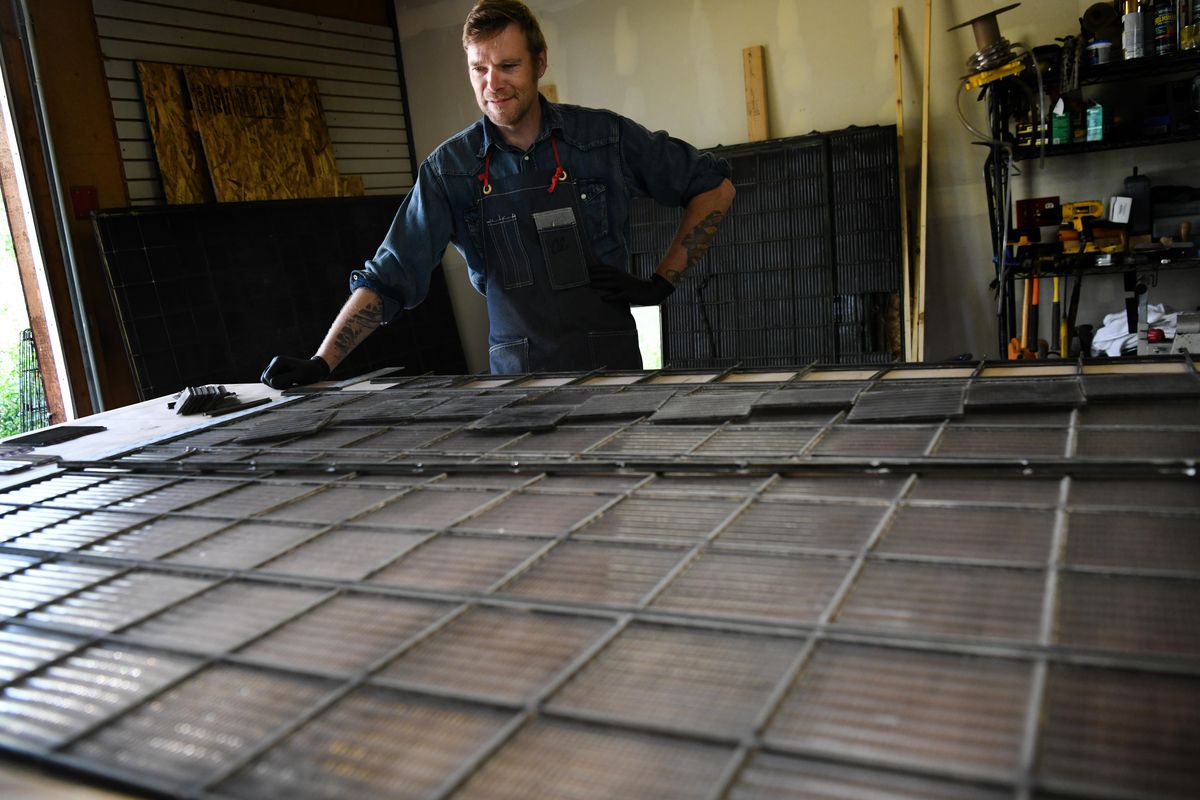Panes-taking process: Long-neglected Otis Hotel’s windows restored

The original leaded windows of the historic Otis Hotel should’ve been history.
Installed in 1911, the grid-patterned, pink-hued glass was uncovered by workers on the building’s restoration project under eight layers of facade – including the most recent fake-brick vinyl siding.
“It’s actually a miracle they survived this long,” said Alex Brannin, 36, who is restoring the windows through his company, American Art Glass. “They were definitely made well when they were made.”
The situation was precarious when Brannin, a custom glass craftsman who also specializes in restoring historic windows, first saw the windows.
“They were in pretty poor shape. Just hanging off the wall by a chance,” Brannin said, noting he removed them “very gently” with a “scientific process of duct tape and hands.”
Now the many panels, some as large as 5-by-7 feet, are in his Elk workshop, where he’s meticulously bringing the 108-year-old windows back to life for re-installation, when they’ll be returned to their rightful place, 10 feet off the ground, topping the storefronts.
Leaded windows, as they’re called, are decorative windows made of small panes of glass separated by metallic “cames,” or dividers. In the Otis’ case, the dividers aren’t lead but zinc. Stained glass windows are the best-known type of leaded windows.
This is Brannin’s first restoration job in the area, but he’s more than prepared. He grew up in the historic window restoration business. His father, Jerry Brannin, taught himself how to restore windows in the 1960s and ’70s as Norfolk, Virginia, where he grew up, was “in the process of gentrification,” Brannin said. “So he was able to go in and pull out a bunch of leaded windows.”
In 1971, Brannin’s father began what would become American Art Glass.
“I grew up in the business, since I was a little kid,” Brannin said. His apprentice work dealt with the stained glass in “churches, synagogues, lots of architectural stuff.” But due to his proximity to America’s colonial past, his restoration work has included 16th century glass artworks imported to the American colonies and American-made decorative art from the 18th century.
During his time in Virginia, he also created original stained glass pieces that are in the chapels of seven U.S. Navy aircraft carriers, including the USS Nimitz, USS George Washington and USS Theodore Roosevelt.
He and his wife, Colleen, moved to Elk in 2013, and Brannin went on a five-year hiatus from glass work. During this time, Colleen sent an email to Megan Duvall, Spokane’s historic preservation officer, letting her know Brannin was in town, if his skills were ever needed.
With the Otis, they were, and they probably will be in the future, said Logan Camporeale, a historic preservation specialist with the city.
“Although it seems like a minute feature for a historic building, it’s one of the defining characteristics of a historic building,” Camporeale said. “Windows are really a big deal.”
Brannin’s presence in the region allows the city and county historic commission to be more bullish about preserving windows, Camporeale said.
“To have somebody that can do that work is really important,” he said. “It’s so easy to lose the glass. Those materials, you’re not going to be able to get them again.”
Brannin agreed. About 70% of the materials he needs to truly restore the windows are no longer available. Besides the lack of ready materials, the work will simply take time. His work to bring back the dozen silver-backed mirror panels for the lobby and 11 windowed panels for the front of the building will take a month, he estimates.
“I’m pretty steadfast when it comes to that,” he said about his consuming devotion to a project once it gets started. “I’ve got a pretty comfortable working environment.”
Brannin said the restored windows will be back in the Otis sometime in August or September, when the building rehabilitation is complete.
“Generally, panels like this are the last thing to go into the building,” he said.
When they do, it will be the latest transformation for the building. The Otis was built in 1911 as the Willard Hotel, a place for transient workers who rented small rooms and shared a communal bathroom on each floor. The hotel changed hands and names many times over the years – in 45 years it went from the Willard to the Atlantic to the Milner to the Earle to, finally, the Otis in 1956.
While the hotel was always linked to a hardscrabble lifestyle, it became a symbol of downtown’s decay near the end of the 20th century. In the mid-1990s, a Spokesman-Review article on the “litter-strewn, two-block strip of West First” described the situation.
“There’s the Handy Market, a sex arcade, the Coach House Restaurant, a homeless-aid office and a place to get free needles, condoms and popcorn,” the 1995 article read. “This slice of Spokane has a high crime rate and such weak political pull the city rarely bothers to clean its streets or sidewalks. It’s so bleak its lone bar is called the Dead End Tavern, where beer pitchers sell for $2, and razors go for 50 cents.”
The 400 people living in the city’s “most dangerous downtown neighborhood” paid as little as $140 a month.
In 2007, the investment group that owned the Otis evicted its tenants, anticipating renovations “to transform the building into sleek stores and possibly apartments.” Instead, the building sat vacant for a decade following the economic crash of 2008.
In 2017, Curtis Rystadt purchased it for $1.4 million and unveiled plans to get the building back up to code for development. Work went apace until March 2018, when the state Department of Labor and Industries halted work after air quality inspectors received complaints that Rystadt didn’t hire a certified contractor to deal with the asbestos, a charge he has denied.
Work began again in June 2018 and has continued since.